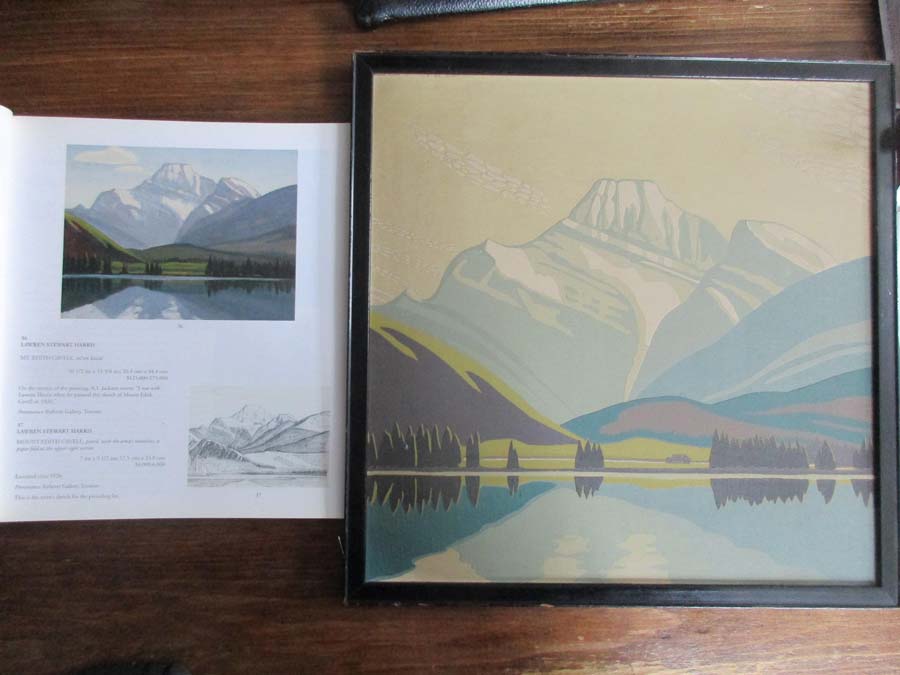|
Written/painted in 2003: Gitsegukla is a Gitxsan
village at the confluence of the Kitseguecla and Skeena rivers
west of Hazelton, with a set of tall, slender totem poles that
are distinctive to the place. It also has an interesting old
United Church, originally Methodist, with sheet-metal spires,
the main one of which has a real "candle-flame" top. The setting
is superb, with Mount Roche de Boule in the distance and a
variety of village houses along the street. Perhaps only
Hagwilget Village near Hazelton, with its Catholic church, St.
Mary Magdalen, on the high ground, gives an equivalent evocation
of the missionaries and their once-dominant role in the villages
along the Skeena. By comparison, the totem poles at Gitanyow and
Kispiox dominate their villages. Hagwilget,
its church built by Father Morice in 1908, was the "outpost of
Catholicism" in the Babine district; the villages to the west
along the Skeena were divided between the Anglicans (such as
Kitwanga with St. Paul's) and the Methodists (such as Kispiox
and Kitsegukla), while some Kispiox villagers who had become
members of the Salvation Army founding the community of Glen
Vowell in 1898 (Glen Vowell is a very tidy, orderly village,
with a large church near the Kispiox River and a very
interesting, Victoria- style band administration office, built
by local carpenters in the 1970s).
From
the United Church of Canada British Columbia Conference
Archives: "Presbyterian work in Hazelton began around 1911
and was confined to that town until the following year when New
Hazelton came into being as a railway construction center.
During the year 1912 the Mission consisted of two towns, New
Hazelton and Old Hazelton with headquarters at Old Hazelton. In
October of 1912 headquarters of the Mission was moved to New
Hazelton where a hall was built in the early summer of 1913.
Later on in 1913, owing to many families changing their place of
residence from Old Hazelton to other parts of the district it
became necessary to close down the mission in Old Hazelton. In
1925 the New Hazelton Presbyterian Church voted against Church
Union but it could not get supply. An arrangement was made
whereby the United Church took over the work in that community.
At that point it was recognized as a United Church. The first
Methodist religious services in Hazelton were held in a room
over a drug store in 1912. The congregation quickly grew so
large that they had to rent the St. Andrew's Hall. Around 1920
St. Andrew's Hall was destroyed by fire. In 1922 Hazelton
Methodist Church was built in Hazelton. According to the United
Church yearbooks, Hazelton Pastoral Charge has had many
different preaching points over the years. Various congregations
have moved in and out of the pastoral charge. Today Hazelton
Pastoral charge includes Gitsegukla and Hazelton, but for
several years in its past history it has included Kispiox,
Skeena River, Cedarvale, and Miller Memorial United Church (at
Wrinch Memorial Hospital) as well as small preaching points in
the area."
The place is also known as Skeena Crossing, due to the GTPR's
crossing of the river nearby.
Note on the Gitxsan from the Chief's
Page: There are approximately 10,000 members of the
Gitxsan nation worldwide, with about 70% living on the
traditional territories. The population is young compared to
provincial and Canadian statistics with over 70% under the age
of 30. Most live in five Gitxsan villages (Gitwangak,
Gitsegukla, Gitanmaax, Glen Vowell, Kispiox) and two provincial
municipalities (Hazelton, New Hazelton). The Gitxsan people make
up about 80% of the total population living on the territories.
The remaining population is mostly of European descent.
Settlement of the area by non-Gitxsan began around the turn of
the century. Gitxsan people have lived on the territory since
creation. Western archaeological evidence has so far supported
more than 10,000 years of occupation by the Gitxsan. The English
translation of the Gitxsan is "People of the River of Mist".
--------
[the long thread below is answered at the bottom, in 2017]
From Sennan Vandenberg, 2015: I came across an article
from your web site [below] regarding the excerpt by Jim Finlay
on the A. Y. Jackson. This is more about sharing another early
serigraph from Sampson Matthews and Nu-Tec. I'm curious if the
stamp on the back of the Jackson is the same as mine? Any chance
do you recognize the location of mine? I've been collecting
early Canadian Serigraphs and John's is the first I've come
across with the possible same early stamp by Sampson Matthews
and Nu-Tec.
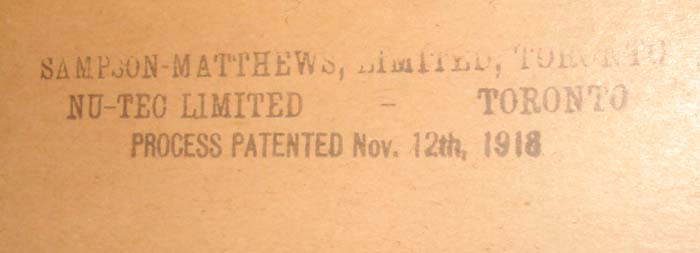
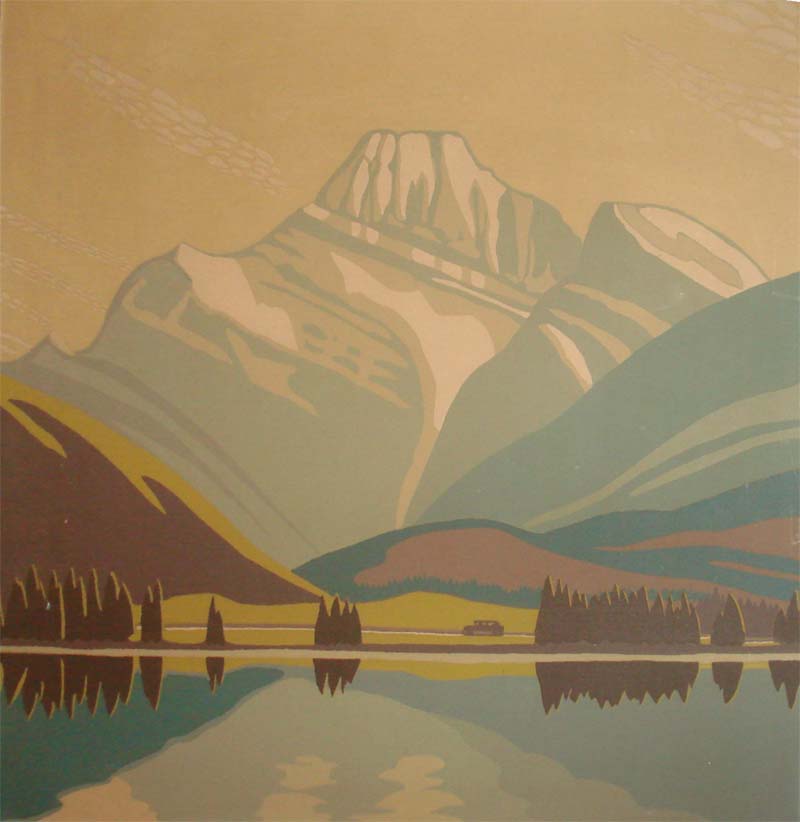
[My – i.e. Michael Kluckner's – guess is that this is Mount
Cheam at the eastern end of the Fraser Valley]
From John Burger, 2015: I am researching a Sampson
Matthews silkscreen that had a notation on the back saying
“Design by A. Y. Jackson.” It belongs to a friend of mine,
purchased some thirty years ago at a yard sale.
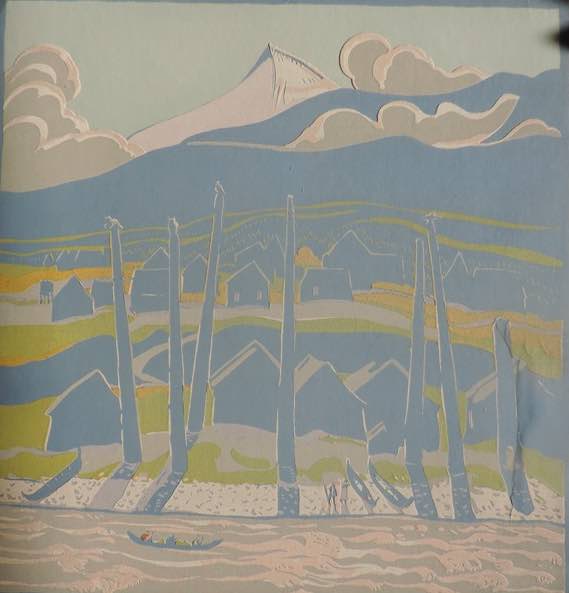
So far, I have been able to definitively establish that the
piece was modeled from a sketch by A.Y. done in 1926. He
visited the Skeena region in 1924. It is about 18-20
inches square. I have also been able to establish that it is not
part of the well documented and researched series of silkscreens
produced by Sampson Matthews from 1942 – 1963 or so. Ian
Sigvaldason is just releasing a book on the War series. I have
been advised that this piece is probably pre war. I have also
learned that other copies of this silkscreen probably exist but
I have not been able to find an image of one yet.
The main reason that I would like to see another copy is that
the one belonging to my friend is apparently extremely faded,
probably from being hung in a sunny location at some point in
its history. I have been told by an authority in these types of
things that when originally produced, the colors would have been
much more spectacular. For example, I was told that the pink you
see in the river would originally have been a vibrant blue that
faded. Titanium Oxide was mentioned. I am not well versed in art
appreciation/techniques in any way. I am just very curious to
see if I can suss out as much history of this piece as possible.
I came across your painting of the church in Gitsegukla on line
and believe the peak you have in the background is the same as
the one in my friend’s piece.
So my reason for contacting you is to see if you might recognize
this piece and know where I might be able to view a copy that is
more true to the original colours. Of course, the Holy Grail
would be to be able to discover that A. Y. Jackson actually did
an oil to serve as the model for this piece. It does not seem
likely at this point. I suspect that this piece would have
been created sometime in the mid to late thirties. A.J. Casson
was at Sampson Matthews at the time and Jackson was also
associated with them.
[at this point Jason Vanderhill, a Vancouver historian with a
special interest in period commercial art, got involved in the
conversation and autocoloured the print … ]
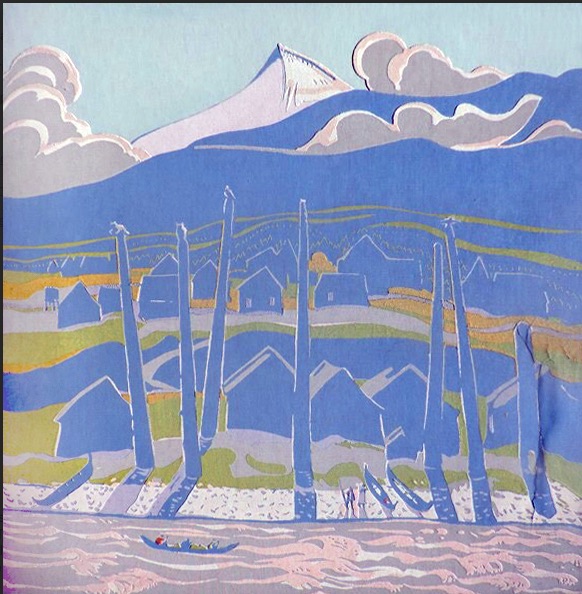
Thanks for this Jason. The autocolour sure makes things more
vibrant. To explain a bit more about the piece. It is heavily
textured. If you look at the clouds on the top right you will
see a dark outline on the left side of one of the clouds. The
photo of the piece was lit by the sun from the left and those
dark lines are actually shadow. So each layer of colour that
went on was quite thick. Early Sampson Matthews work used, I am
told, a thicker type of paint in applying the layers. A real
expert in art has not looked at the piece in detail so my
descriptions are from a truly amateur perspective. My comment
about the titanium, was based on a conversation with someone who
was surmising things from the photo and I may not even have
heard them right. It’s interesting that in the auto coloured
version the same pink is also evident up in the clouds. I just
won’t know how it looked originally unless I can locate another
to compare.
With regard to your link to the Jim Finlay article. He mentions
that he found the sketch for Jackson’s Smart River in Naomi
Jackson Groves’ book A.Y.’s Canada. I was able to look that up
right away as I have this book right now from the library. It
focuses exclusively on his pencil drawings. I had got the book
hoping to find something that referred to my friend’s
piece but there was nothing. I also have Jackson’s 1958
autobiography. In it he speaks at length about the war series of
serigraphs but doesn’t refer to his earlier Sampson Matthews
dealings other than talking of his very good friend Casson being
there. Though not a starving artist, I can imagine Jackson
working with Sampson Matthews during the Depression to bring in
income.
I have included a link
so that you can see the sketch I am referring to. As I look at
it I see that I had dated its creation incorrectly. It was done
in 1928, not 1926.
[And then, a week or so later …]
Hello Jason: It was a link that you provided that led me to the
successful end of my quest. You had copied a link to a story by
Jim Finlay.
http://www.preview-art.com/confessions/confessions11-2007.html
I contacted Mr. Finlay and he quickly put together a package of
info on my friend’s image including the book it was first
published in. It cost me a few bucks but what he provided was
quite detailed and cheap for what he provided.
“The screen print is based on a 1928 gouache over graphite
on board painting by A. Y. Jackson entitled Skeena River (The
Native Town of Gitsegyukla). The painting is in the permanent
collection of the Robert McLaughlin Gallery and was a gifted to
the gallery by Isabel McLaughlin in 1989.” I can’t get a
proper link to embed here but if one goes to The Robert
McLaughlin Gallery site the original can be found under
Accession #1989JA162.
“The painting is reproduced and titled THE NATIVE TOWN OF
GIT-SEGYUKLA On the Upper Skeena on an un-paginated page between
pages 54 and 55 in The Downfall of Temlaham by Marius Barbeau.
The MacMillan Co. of Canada 1928.”
“It is also reproduced and titled Skeena River (The Native Town
of Gitsegyukla) on page 94 of The Group of Seven in Western
Canada. Ed. Catharine Mastin. Key Porter Books. 2008.”
“The painting is also visited by Leslie Dawn on page 132 of his
book National Visions, National Blindness Canadian Art and
Identities in the 1920s. UBC Press 2006. Dawn discusses
Jackson’s trip to the Skeena Valley extensively in chapter 8
entitled. Representing and Repossessing the Picturesque Skeena
Valley, pgs 209 -237. It is interesting to note that Dawn
suggests that the sketch in the collection of The National
Gallery of Canada, to which you refer, was considered for a
poster for the Canadian National Railway and that the resultant
painting was a minor work by Jackson.” It would appear that the
poster never went ahead.
“In my opinion, without having seen the screenprint, it appears
to be unfinished and perhaps in its first ‘state’. As I
mentioned in my earlier e-mail ‘state’ refers to a particular
point in the screenprint production process, in this case a
first state, where the first two or three colours have been laid
down. There may have been other detail and colour to be added at
a later stage in the production process, to give a closer
appearance to the painting. As you can see the screenprint lacks
colour and detail appearing in the painting. Also the
screenprint appears not to contain Jackson’s signature, this
would also suggest that the print was unfinished and had not
completed the print production process.”
From John Burgs, 2015: At the time, I had overestimated
the size of the piece. I took proper measurements the next time
I saw it. It is 12 1/4" by 12 3/4."
Soon after our last contact I was able to locate a 1928 sketch
in the National Gallery collection that is literally the exact!!
match to my friend's piece and was obviously the model for the
print. Here
is the link. On the sketch, the color scheme is written on
the right to guide whoever would be creating the screen print.
CN never did use it. Jim Finlay was also intrigued with seeing
the sketch and has done a piece for Preview:The Gallery Guide
that will appear in the June-August issue. It gives his take on
the piece. For some reason the issue is not on line yet. I have
attached the version he sent to me. He feels that the piece was
probably done in 1928. I am looking for more definitive info on
the date. I do know from research that it had to have been done
between 1928 and October of 1931 when Sampson Matthews would no
longer need to list the patent. I plan on reviewing the
correspondence between Jackson and C.A.G. Matthews and A.J.
Casson (Who was a director of the company)as well as Marius
Barbeau on the slim chance that there is mention of the piece.
I had suspected that it was possible that it was Jackson's
writing on the back of the piece in comparing the writing on
various sketches. More authorities than Jim Finlay had told me
(without me mentioning my thoughts) that the script was typical
of Jackson's.
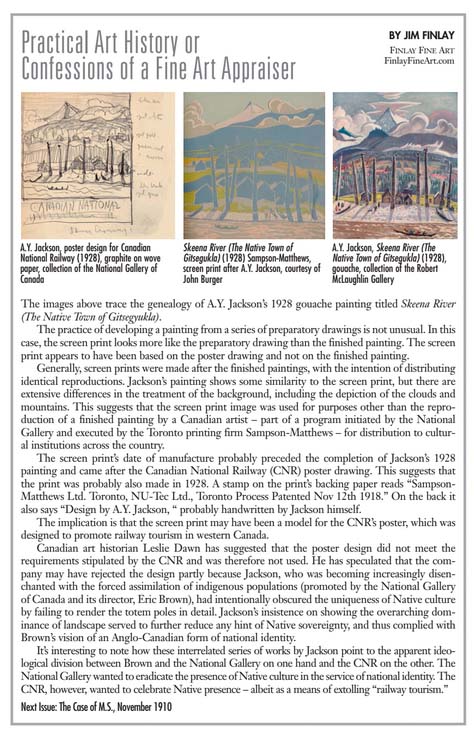
From Sennan Vandenberg, 2017: Just found the location of
my silkscreen it's Mt. Edith Cavell the original was painted by
Lawren Harris.
I found the original with the sketch in a 2002 catalog from
Joyner/Waddington's Canadian Art, picture attached.
|

